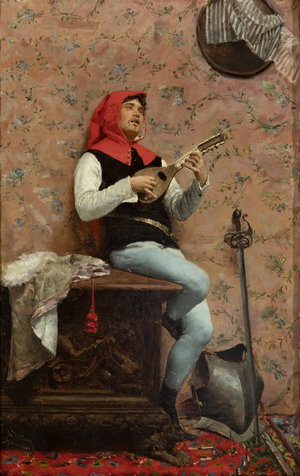Mariano Fortuny: unparalleled virtuosity
Since Goya there has not been a Spanish painter with greater international projection than the one achieved by Mariano Fortuny in his short career. Within a generation of extraordinary painters who elevated Spanish art in the 19th century to its maximum potential, Fortuny captained an absolute renovation of the plastic arts that marked not only those closest to him but also an entire generation of European painters.
After showing a precocious fondness for the arts, the young Fortuny began his academic training at the school of La Llotja where he won the scholarship that would take him to Rome for the first time in 1858. In the Italian capital, Fortuny developed a fundamental part of his career that would deeply mark his personality and artistic projection. In this sense, the many trips that Fortuny made throughout his life meant a constant evolution in his painting, managing to abstract from them a learning process that, with an extraordinary instinct, led him to a completely innovative plastic conception, pushing his painting beyond academic conventions.
“Mandolinero” is an oil painting fully illustrative of the production that he carried out during the first years of his second stay in Rome and in which the multiple influences that he absorbed from his constant travels emerge to merge in an apotheosic exercise of luminous and colorful virtuosity. During this stage, his works frequently starred figures dressed in Italian folk costumes or in medieval costumes that denote Fortuny’s deep knowledge of the pictorial tradition of Renaissance and Baroque art.
His style, marked by an excellent technical mastery, reaches here the perfect balance between the precision of the drawing and the sumptuous recreation of light where the textile and tactile qualities of the flesh tones, together with the high degree of detail, manage to give the male figure an almost sculptural corporeality. In his oil painting technique, precise, colorful and brilliant, he reveals an eagerness to experiment and a constant search for new perspectives on issues such as light capture, which led him to become a pioneer in the construction of shaded effects with tones other than black.
Thanks to this production of an anecdotal nature where his famous cascaron paintings are already foreshadowed, Fortuny reaped an unprecedented success, not only among the artists who followed him, but also among the most prestigious collectors and dealers of the time. His interest in careful observation and the extreme refinement of his creations soon consolidated him as an artist of international fame, giving rise to the term known as “fortunyismo”, to define the style developed by several generations of artists imbued with the painter’s irrepressible creative and innovative spirit.
Extraordinary draughtsman, gifted watercolorist and master of engraving in the wake of his admired Goya, Fortuny raised an unparalleled virtuosity in the nineteenth century that led him to redefine and embody a new concept of the figure of the artist in Spain, being, as many experts argue, the most relevant that has existed between Goya and Picasso.
Despite his unexpected and premature death, we can consider that Fortuny reached the status of an authentic myth during his lifetime, whose true dimension and artistic projection was cut short too soon, leaving us with the everlasting question of how far his talent would have reached.






